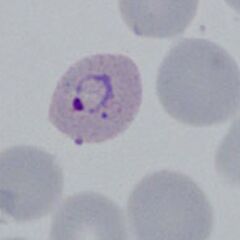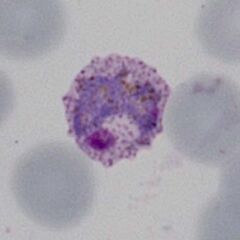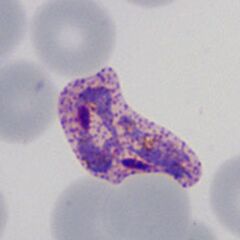P.vivax early trophozoites gallery: Difference between revisions
From haematologyetc.co.uk
No edit summary |
No edit summary |
||
| Line 17: | Line 17: | ||
<gallery mode="traditional" widths=240px heights=240px> | <gallery mode="traditional" widths=240px heights=240px> | ||
File:PVET1.jpg|<span style="font-size:80%">''' | File:PVET1.jpg|<span style="font-size:80%">'''Early double dot form''' Very early red cell changes with fine dots visible</span>|link={{filepath:PVET1.jpg}} | ||
File:PVET2.jpg|<span style="font-size:80%">'''Double chromatin dot form''' Two chromatin dots (sometimes known as "signet ring" form).</span>|link={{filepath:PVET2.jpg}} | File:PVET2.jpg|<span style="font-size:80%">'''Double chromatin dot form''' Two chromatin dots (sometimes known as "signet ring" form).</span>|link={{filepath:PVET2.jpg}} | ||
File:PVET3.jpg|<span style="font-size:80%">'''Accolé form''': The arrowed form is closely associated with the red cell membrane</span>|link={{filepath:PVET3.jpg}} | File:PVET3.jpg|<span style="font-size:80%">'''Accolé form''': The arrowed form is closely associated with the red cell membrane</span>|link={{filepath:PVET3.jpg}} | ||
File:PVET4.jpg|<span style="font-size:80%">'''Multiple parasites''' Two parasites within a single red cells (arrowed)</span>|link={{filepath:PVET4p.jpg}} | File:PVET4.jpg|<span style="font-size:80%">'''Multiple parasites''' Two parasites within a single red cells (arrowed)</span>|link={{filepath:PVET4p.jpg}} | ||
</gallery>" | </gallery>" | ||
Revision as of 14:05, 3 April 2024
Navigation
Go Back
|



